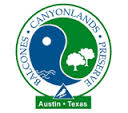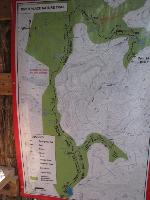River Place Nature Trail Controversy
By Austin Explorer
One of Austin's highest rated hiking trails has been the subject of a dispute between the City of Austin and the River Place Municipal Utility District. The River Place Nature Trail has been wowing hikers for a couple of years now, but some surveying and legal issues have placed some, if not much, of that trail in serious jeopardy of being removed from public use.
Here's a brief rundown on the timeline and issues involved in the dispute. We hope to keep this up-to-date so that area outdoor lovers can keep tabs on an Austin favorite.
1996:
The Balcones Canyonlands Conservation Plan agreement was reached between the City of Austin, Travis County and the U.S. Fish and Wildlife Service that allowed for easier development in the Hill Country in exchange for a system of preserves designed to provide critical habitat for endangered species in the area. Without the agreement homeowners and developers would face more arduous environmental assessments when making changes to the land.
 The agreement is in the form of a 30 year permit and participants expanded to include the Lower Colorado River Authority, the Nature Conservancy and the Audubon Society, among others.
The agreement is in the form of a 30 year permit and participants expanded to include the Lower Colorado River Authority, the Nature Conservancy and the Audubon Society, among others.
Many large developments in the area were able to receive faster track permitting by providing some set aside land that would be managed under the BCCP. If one looks at a map of western Travis County one can see large tracts of preserve and park land, many of which are part of the BCCP.
Note that the BCCP is a program designed to provide habitat for endangered species, not to provide unfettered public access. Though some BCCP lands are opened to the public, some are not.
Though some BCCP lands are open to the public because public access existed on the
property at the time it became part of the BCP, many areas of the preserve are not. Guided hikes are offered through various BCP partner agencies.
2003:
The River Place Municipal Utility District serves the River Place neighborhood with water, waste water and refuse services. This development of land is next door to the Cortaña tract of the BCCP, which is owned by the City of Austin. Like many other MUDs, the River Place MUD also provide parks and recreation services. In 2003 they constructed the first portion of the River Place Nature Trail, represented by the Boardwalk, Lower Panther Trail and the Little Fern Trail segments with trailheads on Big View Drive and the lowest stretch of River Place Boulevard. According to Chuck Reynolds, the trail was constructed in part with a $500,000 grant from Texas Parks and Wildlife.

A map of the expanded trail. The area in dispute lies near the narrowest green section, just south of the emergency exit.
The extension of the trail was opened, consisting of the Upper Panther Trail and Canyon Trail segments with a new trailhead on River Place Boulevard north of the existing one. This completed trail was widely considered to be one of the best and highest rated trails in the Austin area. It was sections of this trail extension that was constructed on City of Austin preserve property.
December 2011:
The City of Austin's Water Utility (the body responsible for management of the city's non-park preserve lands) received correspondence from the U.S. Fish and Wildlife Service indicating part of the trail encroached on the Cortaña tract and that portion which had encroached should be shut down. The city contacted the MUD about the finding at this time.
According to the Amanda Ross, the Austin Water Utility Conservation Program Coordinator, the city was obligated to have the portion of the trail on preserve land removed and the land restored to its previous condition. Failure to do so could cause the permit from the federal government to be in jeopardy.
Out of 3.5 miles of trail overall, approximately 1,600 feet of trail cross over the preserve boundary. The offending trail segment is part of the Upper Panther Trail section. The transgression varies from 10 to 200 feet over the property line according to Sandy Perry, a member of a River Place advocacy group that is seeking to reach a compromise plan with the city and Jim Casey of the River Place MUD.
March 2012:
After some back and forth communication between the city and the MUD portions of the trail were shut down. Signage was erected warning hikers against trespassing onto preserve land and there were reports that wildlife cameras had been put into place to catch those who didn't heed the warnings.
Complicating matters is that the remainder of the Upper Panther Trail and Canyon Trail sections, though on MUD property, are subject to regulations by both the US Fish and Wildlife Service (for the Endangered Species Act) and the US Army Corps of Engineers (for the Clean Water Act). In order to ensure that all applicable regulations were being adhered to the MUD has closed off access to all portions of the trail that were constructed in 2009. Some studies are being conducted to investigate the possibility of opening those sections of trail not on city property. The 1 mile segment at the southern end of the trail are all that remain open at this time.
The MUD is attempting to use the results from a 2012 Texas A&M study that found benefits from having a nature trail near warbler habitat. The presence of periodic walkers was purported to help scatter predators who might prey upon nesting sites, such as coyotes, feral cats, snakes and others. The MUD hopes that the findings of this study will sway the US Fish and Wildlife Service to allow the reopening of the northern section of the trail on MUD property.
September 2012:
The City of Austin and the River Place MUD entered into an agreement that calls for the restoration of the trail section that resides on City of Austin property to its natural state.
December 2012:
Sandy Perry reports the creation of the Friends of River Place Trail website for those wishing to find the latest information and to volunteer to work towards the trail's reopening.
September 2013:
River Place MUD informed the US Fish and Wildlife Service and Corps of Engineers of their intent to sue based on claims that the northern section of the trail (on MUD property) violated permitting. CoE later vacated any action on those claims.
February 2014:
The northern portion of the River Place Nature Trail is reopened. The southern and northern sections remain disconnected due to the segment of trail joining them that had encroached on City of Austin preserve land.
September 2014:
According to Jim Casey, the portion of the trail on COA property has been deconstructed. Efforts are underway to obtain permits needed to construct a bypass to connect the two portions of the trail not part of the disagreement. In the meantime there is a connection being used by hikers on an interim basis.
February 2014:
Sandy Perry reports the River Place Nature Trail work has been completed and the trail has been reopened to the public over its entire route! The Friends of the River Place Trail website reports that a grand re-opening ceremony is in the works.
February 2019:
Four Points News reports the Limited District will start charging non-residents for use of the trail on March 2. The fee, payable by credit card only, is expected to be $10 per person and animal with children under 12 admitted for free. Similar stories in the Austin American-Statesman and Community Impact.
July 13, 2019:
Chuck Reynolds reports that the $10 per person and dog fee is now being charged non-residents on Friday afternoons and weekends.
October 2019:
Community Impact reports the Texas Parks and Wildlife Department is setting up a meeting with the River Place Limited District in which it will press what has already been stated in letter form. TPWD contends that the $10 per person/pet charge for access to River Place Nature Trail is not justified and must be rescinded.
Sources: Thank you to the following people who provided information on the compilation of this timeline.
